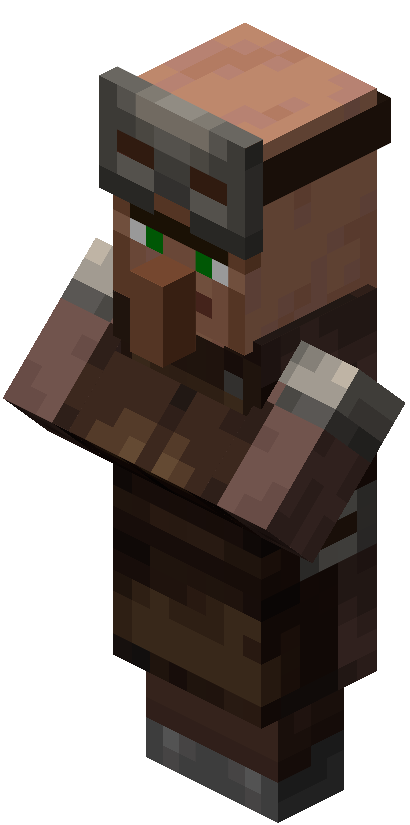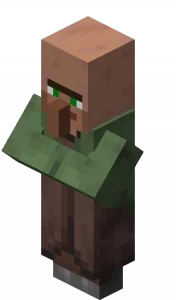In the vast and creative world of Minecraft, preparation is key for survival and exploration. While stone and iron are fundamental for basic equipment, leather plays an important role in the early stages of the game and for aesthetic customization. This is where the Leatherworker villager becomes a valuable artisan in your village.
This specialized villager, an expert in handling leather and crafting armor, offers you the ability to trade your surplus hides for valuable emeralds and, in return, provides leather armor pieces, and even rare items like saddles. If you have a cow or rabbit farm, the Leatherworker can be an excellent trading point. In this comprehensive guide, we’ll explore everything about the Leatherworker villager: how to obtain one, what their trades are at each level, and how you can optimize their presence to equip yourself and enhance your mounts in Minecraft.
Who is the Leatherworker Villager and Why Are They Useful for Your Base?
The Leatherworker villager is a professional villager type in Minecraft who specializes in trading leather and items made from leather. Their role is ideal for players looking for an easy way to obtain leather armor (including its dyed versions), or to acquire special items like saddles without having to rely on dungeon exploration or fishing.
Their primary utility lies in their capacity to purchase large quantities of leather, which makes them an excellent source of emeralds if you have a farm dedicated to cows, rabbits, or horses. In exchange, they offer leather armor pieces, and at higher levels, other hard-to-obtain items.

The Cauldron
For an unemployed villager or one with a different profession to convert into a Leatherworker villager, they need to access and claim a Cauldron block. This is their specific job site block and is fundamental for the Leatherworker to refresh their trades and level up.
The Cauldron is crafted with 7 iron ingots. It’s a versatile block that can hold water, potions, or dye. It’s primarily used for dyeing leather armor and removing dyes from it. When you place a Cauldron near an unemployed villager, there’s a high probability they will adopt the Leatherworker profession, provided it’s daytime and the block isn’t already claimed by another villager.

How to make a Leatherworker Villager
There are two primary ways to obtain a Leatherworker villager in your Minecraft world:
- Finding Them in a Village: Naturally generated villages in the game can contain villagers with various pre-assigned professions. Look for a villager already interacting with a Cauldron or one wearing the Leatherworker‘s distinctive outfit (a brown leather apron and gloves).
- Converting an Unemployed Villager: This is the most controlled method for getting the Leatherworker you need:
- Step 1: Locate a villager who doesn’t have a profession (their outfit will be basic) or one whose profession you wish to change. Important: A villager who has already traded with you in their current profession will not be able to change jobs, so choose wisely!
- Step 2: Place a Cauldron near the villager. Ensure it’s the only accessible job site block for them.
- Step 3: Wait. During Minecraft’s daytime (between 2,000 and 9,000 game ticks), the villager will interact with the Cauldron, and their outfit will change to that of a Leatherworker.
Conversion Process and Locking Trades
Once the villager becomes a Leatherworker, they will generate a random set of trades. If you haven’t traded with them yet, you can break and replace the Cauldron to reset their offers. This is useful if you’re looking for a specific trade, such as the one for saddles. However, once you trade with them at least once, their trades become “locked” permanently.
All Leatherworker Villager Trades by Level
The Leatherworker villager has five profession levels, and their trades unlock as you gain experience with them through commerce. Emeralds are the primary currency, and leather is their main input resource.
Here’s a comprehensive images of possible trades (prices and quantities may vary slightly based on player reputation and other in-game factors):
Novice
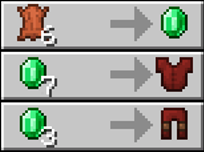
Apprentice

Journeyman
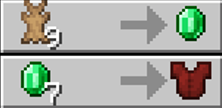
Expert
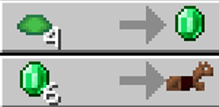
Master

Strategies to Optimize Trading with the Leatherworker
To get the most out of your Leatherworker villager, the key is a consistent supply of leather and optimizing your prices.
Efficient Sources of Leather and Other Hides
The most efficient way to obtain large quantities of leather for trading with the Leatherworker villager is by building automatic cow farms. Cows are relatively easy to breed and provide both beef and leather. An efficient cow farm will allow you to consistently sell leather to the Leatherworker, generating a good flow of emeralds. You can also get rabbit hide from rabbit farms, which can be traded at higher levels.
Discount Trades: The Benefits of Curing Zombie Villagers
As with other villagers, the “zombify and cure” strategy works perfectly with the Leatherworker villager. If you zombify a Leatherworker (by letting a zombie hit them on normal or hard difficulty) and then cure them (with a Potion of Weakness and a Golden Apple), they will offer massive and permanent discounts on all their trades. This is especially useful for buying saddles at a significantly reduced price.
Advantages of Having a Leatherworker Villager at Your Base
Incorporating a Leatherworker villager into your villager trading hall or base provides specific benefits for equipping yourself and improving your mobility in the game:
Access to Leather Armor and Dyed Customization
While leather armor isn’t the strongest, it’s very useful in the early stages of the game. The Leatherworker provides a renewable supply of these pieces. Furthermore, you can dye leather armor using Cauldrons filled with dye, making it a versatile option for customizing your appearance or that of your teammates, adding an aesthetic touch.
Obtaining Saddles Without Exploration
The primary advantage of having a Leatherworker villager is their ability to sell saddles. Saddles are essential for riding pigs, horses, and other mobs, and they are usually difficult to find (in dungeon chests, Nether fortresses, desert temples, etc.).. The Leatherworker offers a renewable source for these items, saving you a lot of time spent exploring and relying on luck.
Frequently Asked Questions About the Leatherworker Villager (FAQ)
Conclusion: The Leatherworker, An Essential Artisan in Your Village
The Leatherworker villager is a valuable NPC in Minecraft, offering you a straightforward way to manage your leather and access unique items that can enhance your exploration and gameplay experience. Their ability to convert your animal hides into emeralds, and in turn, provide you with customizable leather armor and saddles, makes them an incredibly practical asset.
By establishing a Leatherworker in your village and optimizing their trades, such as selling them your surplus leather from farms and applying discounts, you’ll ensure a consistent flow of important resources. Don’t underestimate the utility of this leather specialist; the Leatherworker villager is a vital link in the production chain of your Minecraft world.
